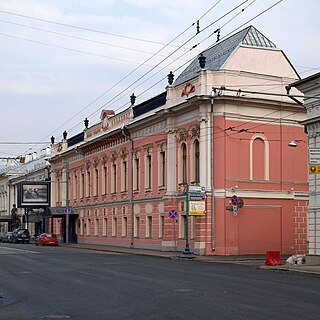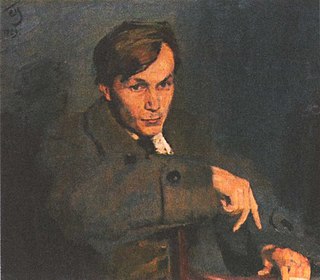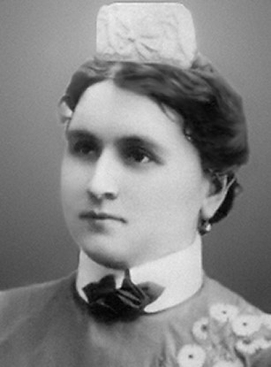
The Kazan Art School is a state autonomous education institution in Kazan, Republic of Tatarstan. It's one of the oldest art schools in Russia, with a continuous history of more than 100 years. [1]

The Kazan Art School is a state autonomous education institution in Kazan, Republic of Tatarstan. It's one of the oldest art schools in Russia, with a continuous history of more than 100 years. [1]
The school was founded in 1895 as a branch of the Imperial Academy of Arts. In its early years, it had four departments: painting, engraving, architecture, and sculpture. [2] Early graduates included P.P. Benkov, Alexander Grigoriev and Nicolai Fechin, for whom the school is now named. Architect Carl Myufke headed the architecture department, designed the grand school building completed in 1904, and served as director until 1908.
In 1918 the Kazan Art School was transformed into Kazan Free Art Studios, then in 1921 because officially known as the Kazan Art and Technical Institute. [3] In these years the school was the basis for a series of several well-known Kazan artists groups: "The Sunflower" (1918) which combined the aesthetics of modernism to avant-garde trends; "Rider" (1920-1924) which announced the development of engraving as an independent art; "Tatar Left Front of Art" (TatLEF) (1923-1926); the "Declaration of Five" (1927); and the "Tatar Association of Artists of Revolutionary Russia "(TatAHRR) (1928), the regional branch of the national AKhRR socialist realism association.
The school remained open through the war years, and continues to provide high-level arts education and training. [4]

Tatarstan, officially the Republic of Tatarstan, sometimes also called Tataria, is a republic of the Russian Federation, located in Eastern Europe. It is a part of the Volga Federal District; and its capital and largest city is Kazan, an important cultural centre in Russia.

Kazan is the largest city and capital of Tatarstan, Russia. The city lies at the confluence of the Volga and the Kazanka rivers, covering an area of 425.3 square kilometres, with a population of over 1.3 million residents, up to roughly 1.7 million residents in the metropolitan area. Kazan is the fifth-largest city in Russia, and the most populous city on the Volga, as well as the Volga Federal District.

Kazan Federal University is a public research university located in Kazan, Russia.

Söyembikä Tower, also called the Khan's Mosque, is probably the most familiar landmark and architectural symbol of Kazan.

Bauman Street is a pedestrian street in the heart of Kazan, the capital of Tatarstan, Russia. It is named after Nikolay Bauman, a Russian revolutionary, and is located in the central part of the city. The street starts at the foot of the Kremlin and reaches Tukay Square, the central square in the city.

Stepan Dmitrievich Erzia (Nefyodov) (Russian: Степа́н Дми́триевич Э́рьзя (Нефёдов); November 8 [O.S. October 27] 1876 – 24 November 1959) was a Mordvin sculptor who lived in Russia and Argentina. Erzia chose his pseudonym after the native ethnic group, the Erzya Mordvins.

Urmançe Ğäbdelbaqí İdris ulı, a.k.a.Baqi Urmançe was a Tatar painter, sculptor and graphic artist, and a pedagogue. He received the following awards and titles: People's Artist of Tatar ASSR (1960), People's Artist of the Russian SFSR (1982), and laureate of the Ğabdulla Tuqay Tatar ASSR State Prize (1967).

Nurlatsky District is a territorial administrative unit and municipality of the Republic of Tatarstan within the Russian Federation. The administrative center of the district is the city of Nurlat. In 2020, the population of the district was 58,290. Almost half of the district population lives in the district center.

Russian Academy of Arts is the State scientific Institution of Russian Federation, eligible heir to the USSR Academy of Arts. The Academy is an heir to traditions of the Imperial Academy of Arts established in 1757 to promote the development of Russian art. RAA is the public cultural Institution—a counterpart of the Russian Academy of Sciences in the field of fine arts, architecture, decorations, design and art education. A founder of RAA is the Government of the Russian Federation.
Tatar State University of Humanities and Education is a university in Kazan, Russian Federation. It was formed in 2005 by a merger of several institutions, some which had a particular focus on the use of Tatar as a medium of instruction or the study of the language itself, for example the Kazan State Pedagogical University and Tatar State Humanities Institute. The university is considered a successor to Kazan State Pedagogical University, the third oldest pedagogical university in Russia, after Moscow State Pedagogical University and Hertzen Russian State Pedagogical University in Saint Petersburg.

The National Library of the Republic of Tatarstan is the main state book depository in Tatarstan for national, republican, Russian and foreign publications. It holds over three million documents, including over 100,000 documents in the Tatar language and another 100,000 in foreign languages. [1] It “is the centre of the propagation of the culture of the Tatar people, a unique public library performing the functions of acquisition, preservation and distribution of Tatar books and literature of the republic.” [2]

Islam in Tatarstan existed prior to the tenth century, but it began major growth in 922, when Bulgar ruler Almış converted to Islam. This was followed by an increase in missionary activity in Volga Bulgaria. Islam remained the dominant religion through the Mongol invasion and subsequent Khanate of Kazan. In 1552, the region was finally conquered by Russia, bringing the Volga Tatars and Bashkirs on the Middle Volga into the tsardom. Under Russian rule, Islam was suppressed for many years, first during the Tsardom and Empire and later during the Soviet era. Today, Islam is a major faith in Tatarstan, adhered to by 33.8–55 percent of the estimated 3.8 million population, making it one of the two dominant religions in the region, the other being Orthodox Christianity.
Street Ğädel Qutuy is a highway in the city of Kazan, Republic of Tatarstan, Russia. It is named in the honor of Tatar writer, poet and playwright Ğädel Qutuy. The highway connects the eastern part with the central part of the city. The highway runs from north-west to south-east.

Institute of Philology and Intercultural Communication, formerly Kazan Imperial University, is a higher educational institution of Kazan, one of the largest institutes of Kazan Federal University. IPIC has more than 4500 students, 300 teachers and staff members, including 58 Ph.D and 175 candidates of sciences, 11 teachers from foreign countries. The Institute comprises 3 academic divisions: the Leo Tolstoy Higher School of Russian and Foreign Philology, the Gabdulla Tukay Higher School of National Culture and Education and the I.A. Baudouin de Courtenay Higher School of Russian Language and Intercultural Communication. The Institute trains philologists and educators with expertise in linguistics, literary studies, Russian, Tatar and foreign languages, interpretation and translation, educational technologies, design, music, and choreography.
Elabuga Institute (branch) of KFU is a state educational institution of higher professional education of the Russian Federation.

Alexander Vladimirovich Grigoriev, was a Mari Soviet artist, public figure and academician. He is considered to be the first-renowned and the greatest Mari artist, who contributed to the development and formation of the fine arts in the Mari Territory.

The A.V. Grigoriev Art and History Museum is one of the oldest art galleries in the Volga region, founded in 1919 by Alexander Grigoriev in Kozmodemyansk, Mari El Republic. Branch of the municipal institution " Kozmodemyansky cultural and historical museum complex ".

Fatykha Abdulvalieva Aitova was a Tatar philanthropist and educator, and the founder of the first women's gymnasium in Kazan.

Märcaniä was a madrasa in Kazan attached to the Märcani Mosque.
Liya Zakirovna Shakirova was a Soviet and Russian linguist, professor of pedagogical science and teacher-methodologist. She worked at Kazan State Pedagogical Institute from 1948 until her retirement in 2003 and authored approximately 420 scientific articles that included textbooks on Russian language teaching methology, teaching methods and manuals for students and teachers at universities. Shakirova received the Order of Lenin, the Medal "Veteran of Labour" and the Medal "For Valiant Labour in the Great Patriotic War 1941–1945" in her lifetime.
Coordinates: 55°47′29″N49°08′07″E / 55.791439°N 49.135208°E